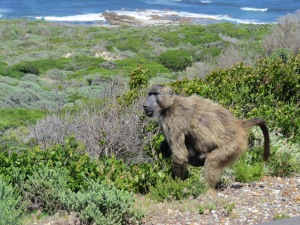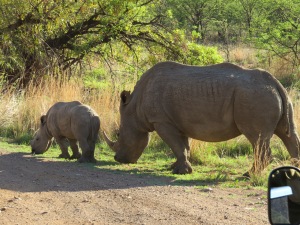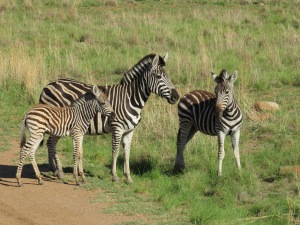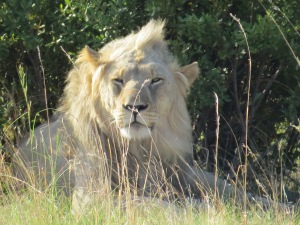How can I choose just 5 photos of stunningly beautiful South Africa? The scenery – mountains, ocean, veldt. The people – a troupe of roadside dancers, a diamond cutter, a drum instructor with his djembe. The food – Cape Malay samosas, cassava bread, rooibos tea. The animals – penguins, baboons, white rhinos, elephants, lions.
No, I can’t possibly show you my South Africa adventure in just five photos. But, I’ll try to show you the amazing animals I saw in these five images:
An African penguin (Spheniscus demersus) at Boulders Beach, on the Cape Peninsula, outside of Cape Town. Two breeding pairs settled on this beach in 1982 and since then the penguin colony has grown to about 3,000 birds.
Baboons were everywhere — by the side of the road, rooting through trash cans in Sun City’s water park, scampering up the stone walls of Camps Bay estates. Although we were enchanted by the sight of them, the locals view them as an over-abundant nuisance, the way I view white-tail deer where I live in Pennsylvania. This mother and baby were spotted on the road leading to Cape Point nature reserve.
This white rhino mother and baby were in Pilanesburg National Park, about two hours north of Johannesburg. The white rhino, (Ceratotherium simum) is more abundant than the black rhino, but still scarce. The white rhino consists of two subspecies: the Southern White Rhino, (seen here) with an estimated 17,480 wild-living animals, and the much rarer Northern White Rhino. The northern subspecies is said to have eight remaining worldwide, all in captivity. It was amazing to be so close to these rhinos and hear the mother grunt and snort at her young.
More mothers with their babies, this time a Cape Mountain zebra (Equus zebra zebra) and her young at Pilanesburg National Park. We traveled to South Africa in late November and early December. In the Southern Hemisphere this is springtime and thus a great time to see young animals.
The Big Five refers to the lion, African elephant, Cape buffalo, leopard, and rhinoceros. The term Big Five was initially coined by big-game hunters to refer to the five most difficult animals in Africa to hunt on foot. Fortunately, these days it’s used to refer to the animals you’ve seen, not shot. At Pilanesburg, we were fortunate to see four of the Big Five — only the leopard eluded us. On day two of our safari we spotted this majestic lion resting in the grass in the early morning sunshine.




